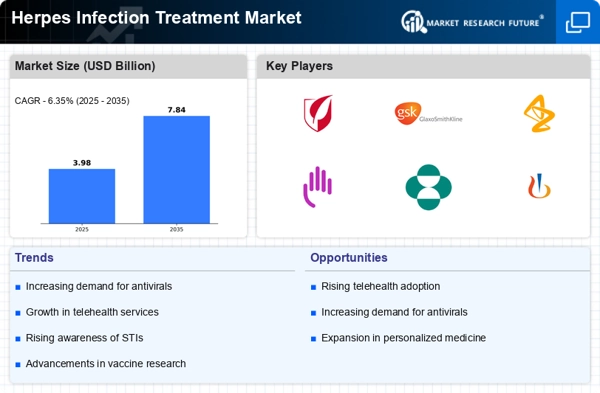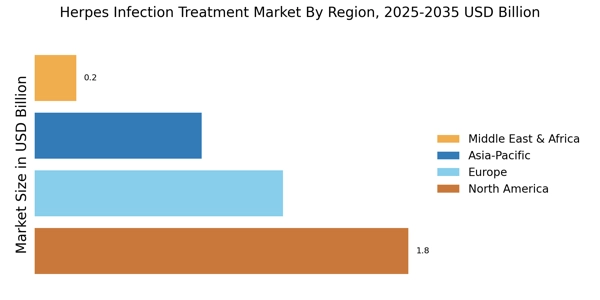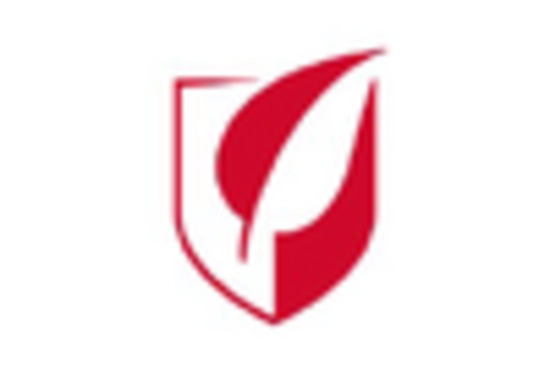Increased Focus on Sexual Health
The growing emphasis on sexual health and wellness is driving the Herpes Infection Treatment Market. Public health campaigns aimed at reducing stigma associated with sexually transmitted infections (STIs) have led to increased testing and treatment-seeking behavior among individuals. As society becomes more open about discussing sexual health, individuals are more likely to seek information and treatment for herpes infections. This cultural shift is supported by healthcare providers who are increasingly integrating sexual health into routine medical care. The rise in sexual health awareness is likely to result in higher demand for herpes treatment options, thereby expanding the market. Additionally, educational initiatives that inform the public about the importance of early diagnosis and treatment are expected to further enhance the visibility of the Herpes Infection Treatment Market.
Innovations in Antiviral Therapies
Innovations in antiviral therapies are significantly influencing the Herpes Infection Treatment Market. The development of new antiviral drugs and treatment regimens has the potential to improve patient outcomes and reduce the frequency of outbreaks. Recent advancements in drug formulations, such as long-acting injectables and combination therapies, are being explored to enhance efficacy and patient adherence. The market is witnessing a shift towards personalized medicine, where treatments are tailored to individual patient profiles, potentially leading to better management of herpes infections. As pharmaceutical companies invest in research and development, the introduction of novel therapies is expected to create competitive advantages and expand treatment options available to patients. This trend not only addresses the medical needs of those affected but also contributes to the overall growth of the Herpes Infection Treatment Market.
Integration of Telehealth Services
The integration of telehealth services is transforming the landscape of the Herpes Infection Treatment Market. Telehealth platforms provide patients with convenient access to healthcare professionals, enabling them to seek advice and treatment for herpes infections from the comfort of their homes. This trend has been particularly beneficial for individuals who may feel embarrassed or stigmatized about seeking in-person care. The rise of telemedicine has led to increased patient engagement and adherence to treatment plans, as patients can easily communicate with healthcare providers. Furthermore, telehealth services can facilitate timely diagnosis and management of herpes infections, potentially reducing the spread of the virus. As telehealth continues to gain traction, it is likely to play a crucial role in shaping the future of the Herpes Infection Treatment Market.
Rising Prevalence of Herpes Infections
The increasing incidence of herpes infections is a primary driver for the Herpes Infection Treatment Market. Recent estimates suggest that a significant portion of the population is affected by herpes simplex virus type 1 and type 2, with millions of new cases reported annually. This rising prevalence necessitates effective treatment options, thereby propelling market growth. As awareness about the condition expands, more individuals seek medical advice and treatment, further stimulating demand. The Herpes Infection Treatment Market is likely to experience heightened activity as healthcare providers respond to this growing need, leading to innovations in treatment methodologies and increased availability of antiviral medications. Furthermore, the economic burden associated with herpes infections, including healthcare costs and lost productivity, underscores the urgency for effective treatment solutions, thereby enhancing market dynamics.
Growing Investment in Healthcare Infrastructure
The growing investment in healthcare infrastructure is a significant driver for the Herpes Infection Treatment Market. Governments and private entities are increasingly allocating resources to enhance healthcare facilities and improve access to medical services. This investment is particularly relevant in regions where healthcare access has been historically limited. Improved infrastructure enables better diagnostic capabilities and treatment options for herpes infections, thereby fostering market growth. Additionally, the establishment of specialized clinics and treatment centers dedicated to STIs, including herpes, is likely to enhance patient care and outcomes. As healthcare systems evolve and expand, the Herpes Infection Treatment Market is expected to benefit from increased patient access to effective treatment solutions, ultimately contributing to better public health outcomes.


















Leave a Comment